FROM THE GARDEN
BUG ZONE
NUISANCE PEST LIST

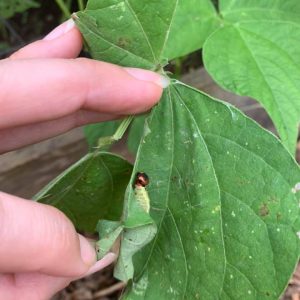
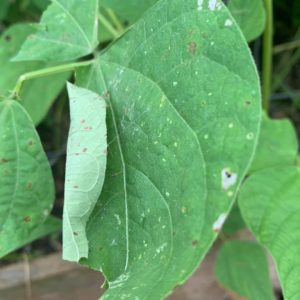
BEAN LEAFROLLER SKIPPER (Urbanus proteus)
FOUND ON: Legumes in late summer
CHARACTERISTICS:
- Green caterpillars with yellow stripes and black speckling, with a rather large brown head and a distinct neck.
- Generally found rolling up in bean leaves
- Adult is the longtailed skipper.
WHAT THEY DO:
The bean leafroller caterpillar stage feeds on legumes, where it rolls the leaf up and feeds within that shelter. Look for ragged and rolled up leaves.
TREATMENTS / SOLUTIONS:
- This is a minor pest that usually doesn’t cause too much issue in my experience, but if you find them bothersome you can easily remove them and place somewhere else.
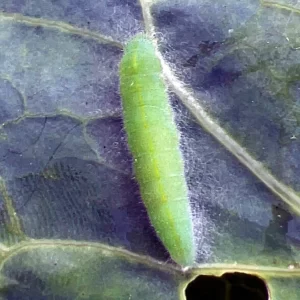
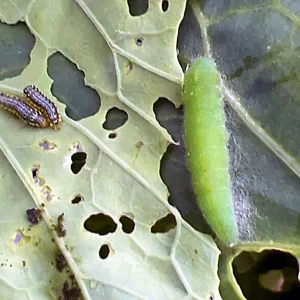
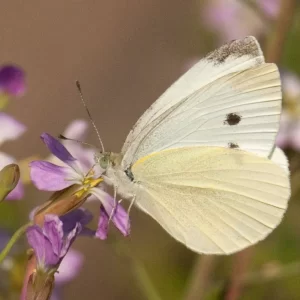
CABBAGE WORM (Pieris rapae)
FOUND ON: Brassicas (cabbage, broccoli, kale, collards)
CHARACTERISTICS:
CHARACTERISTICS:
- Slightly hairy green caterpillar.
WHAT THEY DO:
Foliage feeder – they feed on the undersides of leaves, leaving the clear upper epidermis of the leaf intact creating a “windowpane” effect.
TREATMENTS / SOLUTIONS:
- Cover your crops in a row cover or netting to deter moths
- Early prevention is best by finding and removing eggs and larvae
- Bt organic bacteria-based spray – DIRECT PRODUCT LINK HERE
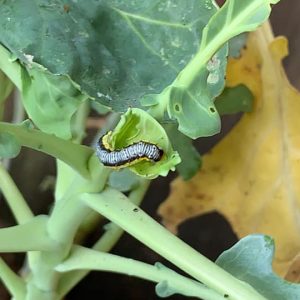
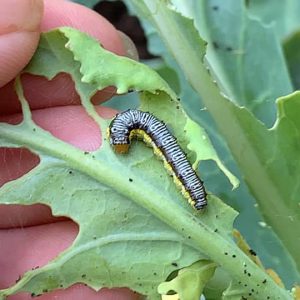
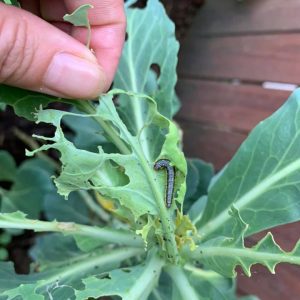

CROSS-STRIPED CABBAGE WORM (Evergestis rimosalis)
FOUND ON: Brassicas (cabbage, broccoli, kale, collards)
CHARACTERISTICS:
- Larvae are small black and white striped caterpillars with yellow sides and a brown head.
- Full grown caterpillars are about 3/4 inch long.
- Adult is a small brown and cream moth with a wingspan around 25mm.
- The eggs are laid in small clusters (3-25) underneath leaves and are 1.2 mm x 0.9 mm each.
WHAT THEY DO:
Foliage feeder – they feed on the undersides of leaves, leaving the clear upper epidermis of the leaf intact creating a “windowpane” effect.
TREATMENTS / SOLUTIONS:
- Cover your crops in a row cover or netting to deter moths
- Early prevention is best by finding and removing eggs and larvae
- Bt organic bacteria-based spray – DIRECT PRODUCT LINK HERE
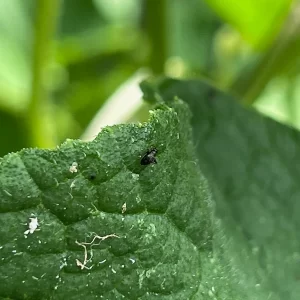
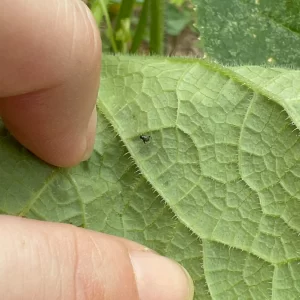
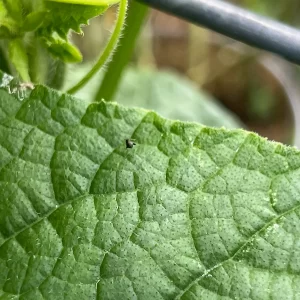
FLEA BEETLES (Phyllotreta cruciferae)
FOUND ON: Radishes, broccoli, cabbage, turnips, eggplant, peppers, tomatoes, potatoes, spinach and melons.
CHARACTERISTICS:
- Most adult flea beetles are very small (1/16 –1/8 inch long), but they have large back legs used for jumping, especially when disturbed. This gives them a flea-like appearance.
- Flea beetles can be black, bronze, bluish or brown to metallic gray.
- Small white larvae hatch from eggs and feed on the roots of the newly planted seedlings.
- Larvae transform into pupae in the ground.
WHAT THEY DO:
Foliage Feeders – Flea beetles chew irregular holes in the leaves. Severe flea beetle damage can result in wilted or stunted plants.
TREATMENTS / SOLUTIONS:
- Control weeds in and around planting sites to limit food sources for flea beetles.
- Remove old crop debris so that beetles will not be able to get protection in the winter.
- Use row covers or other netting to keep beetles away while the smaller seedlings are growing.
- Remove row covers before the flowers come up so pollinating insects can reach the plants.
- Plant a highly-favored trap crop, such as radishes.
- Sprinkle plant leaves with diatomaceous earth.
- Cover plants with netting until flowers form and pollination is needed.
- Crop rotation.
- Organic chemistries include spinosad (Entrust), Surround WP (kaolin clay), and pyrethrin (Pyganic).
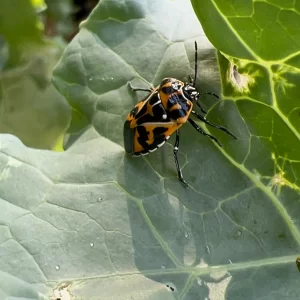

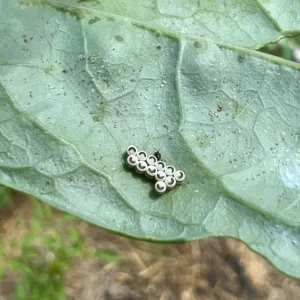
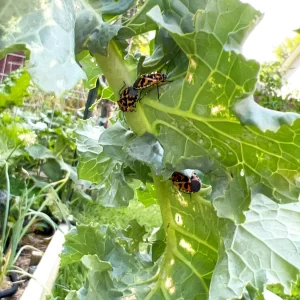
HARLEQUIN CABBAGE BUGS (Murgantia histrionica)
FOUND ON: Brassica plants (cabbage, broccoli, kale, mustard), turnip, radish, horseradish.
CHARACTERISTICS:
- Adult beetles are mostly black with orange “harlequin” pattern marking. They are small with a shield-shaped body typical of stink bugs, including the foul odor from scent glands when threatened.
- The eggs are oval-shaped (barrel-like), white with black bands, and laid in clusters on the underside of plant leaves.
- The nymphs resemble small adults but lack fully developed wings.
WHAT THEY DO:
Sap Suckers – Adults and nymphs feed on the stems and leaves of plants, often causing blotching.
TREATMENTS / SOLUTIONS:
- Early prevention is best by finding and removing adults, eggs, and nymphs.
- Knock them into soapy water.
- Spray insecticidal soap or a soap water solution.
- Cover plants with netting.
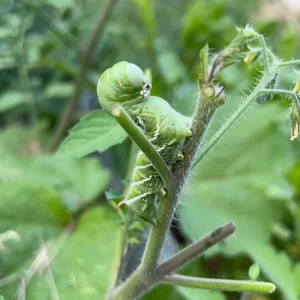
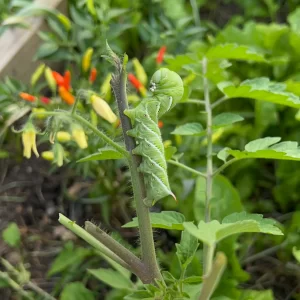
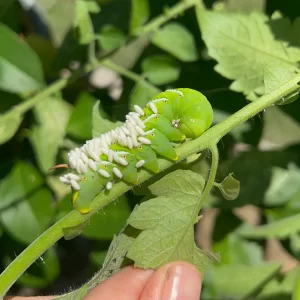
HORNWORM (Manduca quinquemaculata or Manduca sexta)
FOUND ON: Tomatoes.
CHARACTERISTICS:
- There are two types that look and act alike: Tomato Hornworm (Manduca quinquemaculata) and Tobacco Hornworm (Manduca sexta)
- Adult is a brown and gray hawk moth of the family Sphingidae.
- The caterpillar gets its name from a dark projection on their posterior end.
- Tomato hornworms are closely related to (and sometimes confused with) the tobacco hornworm and Blackburn’s sphinx moth (Manduca blackburni).
- If you see cocoons all over one and it isn’t moving much, LEAVE IT! The hornworm is paralyzed after being eaten from the inside by Braconid larvae, and they have burrowed out to make cocoons. Braconid wasps are a tiny wasp and beneficial predator of hornworms.
- Look for segmented, grenade-looking green or brown poops.
WHAT THEY DO:
Defoliators – They will strip a plant of most of its leaves, including stems.
TREATMENTS / SOLUTIONS:
- Remove and relocate. You can use a BLACKLIGHT FLASHLIGHT at night to spot them (they glow).
- Knock them into soapy water.
- Bt organic bacteria-based spray – DIRECT PRODUCT LINK HERE
- Encourage the population of braconid wasps in your area. If you see cocoons all over one, LEAVE IT! Those are Braconid wasp cocoons and they are a beneficial predator of hornworms.
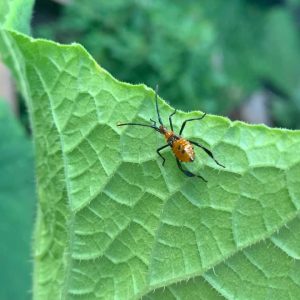
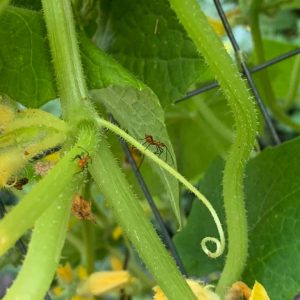
LEAFFOOTED BUGS (Leptoglossus phyllopus)
FOUND ON: Mostly nightshades (tomato, eggplant, peppers), but can go after other crops
CHARACTERISTICS:
- Eggs are brown and laid in a single row along a stem or leaf. They are cylindrical and closely laid end to end.
- Young nymphs look almost like large red ants, but include black legs and markings.
- Adult beetles are black with a yellow/white stripe and a leaf-shaped area on their legs, hence the name.
WHAT THEY DO:
Sap Suckers – they have piercing-sucking mouthparts that allow them to feed on plant parts, but they especially like ripening fruit, causing premature color break and fruit drop.
TREATMENTS / SOLUTIONS:
- Early prevention is best by finding and removing adults, eggs, and nymphs.
- Knock them into soapy water.
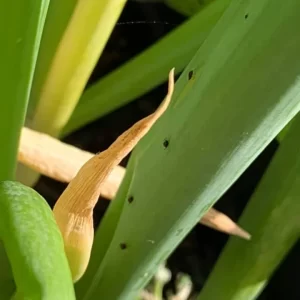
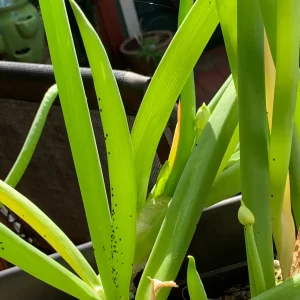
ONION APHIDS (Neotoxoptera formosana)
FOUND ON: Onion family greens
CHARACTERISTICS:
- Tiny reddish-brown or black bugs usually in large groupings
WHAT THEY DO:
They feed by sucking sap from the plant, causing damage and potentially transmitting viruses. They seem to prefer walking onions and shallots, but not chives.
TREATMENTS / SOLUTIONS:
- Spray them off with water as soon as possible.
- Try spraying insecticidal soap or mix a little Dawn dish soap in water.
- Encourage beneficial aphid-eating bugs, like ladybirds, praying mantis, hoverflies, lacewings and their respective larvae, plus predatory wasps. These beneficial insects also dine on nectar from many flowers, so try growing herbs like oregano and dill, and flowers like sweet alyssum, nasturiums, buckwheat, and bachelor buttons.
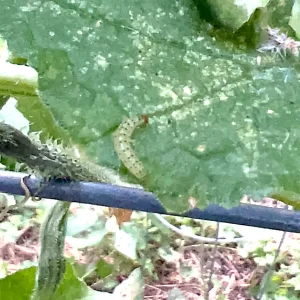
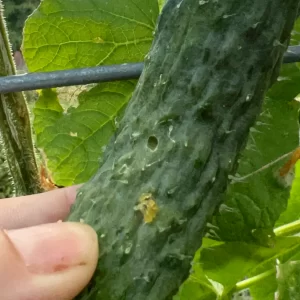


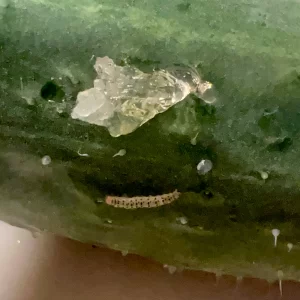
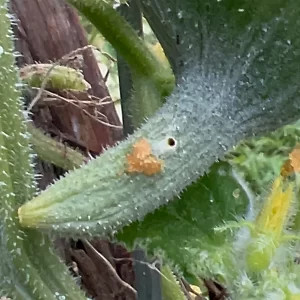
PICKLEWWORM (Diaphania nitidalis)
FOUND ON: Cucurbits (squash, cucumber, and melon plants)
CHARACTERISTICS:
- Larvae are thin white caterpillars with numerous small black spots. As they mature they darken in color and lose their spots.
- Adult is a flashy iridescent brown moth with wide triangular wings and a wingspan of about one inch. Adults are not active during daylight hours and eggs are laid only at night.
- Tiny eggs are laid in small clusters on the plant, near flowers, shoots, and new leaf buds.
WHAT THEY DO:
They drill perfectly round holes and burrow inside of squash, cucumbers, and melons to feed. They often leave behind a yellow or clear gelatinous frass (poop).
If you can get the worms out, you can often still use the vegetable by cutting around the areas they chewed into but often kill young premature vegetables.
TREATMENTS / SOLUTIONS:
There are no good organic commercial treatments for squash beetles that I know of.
- Place the item in a large container of water. The worm will climb back out and drown.
- Organic options include insecticidal soaps, pyrethrins, and kaolin clay sprays.
- Bt organic bacteria-based spray, but it had to be on the plant prior to the worm burrowing into the item – DIRECT PRODUCT LINK HERE
- Plant more resistant varieties like butternut, golden Hubbard, and Improved Green Hubbard.
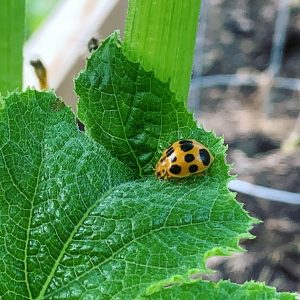

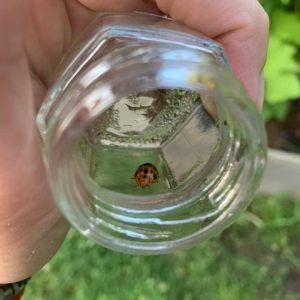
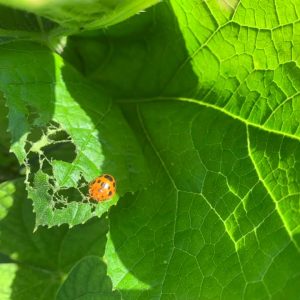
SQUASH BEETLES (Epilachna borealis)
FOUND ON: Cucurbits (squash, cucumber, and melon plants)
CHARACTERISTICS:
- Adult is a gold/orange-colored beetle with black spots
- Looks similar to a lady bug but is about double the size
- Eggs are small, long, yellow, and laid in big clusters on leaves
- Larvae are yellow with six rows of barbed, black spines
WHAT THEY DO:
Squash beetle larvae feed on the underside of leaves, whereas the adults may feed on either surface, or sometimes on the skin of the vegetable itself, leaving behind a spiral-shaped injury.
TREATMENTS / SOLUTIONS:
There are no good organic commercial treatments for squash beetles that I know of.
- Early prevention is best by finding and removing adults, eggs, and larvae.
- Knock them into soapy water.
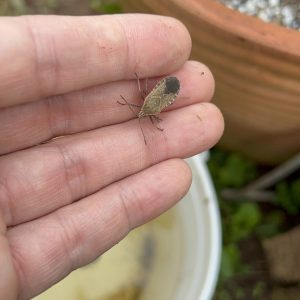
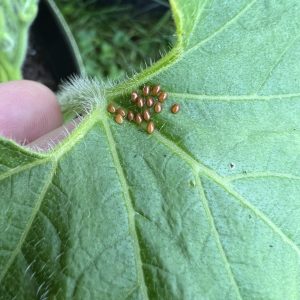

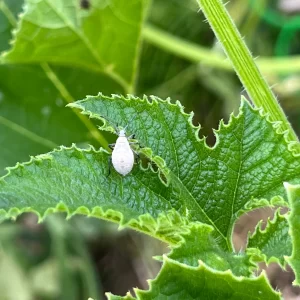

SQUASH BUGS (Anasa tristis)
FOUND ON: Cucurbits (mostly squash in particular, but also pumpkins, melons, etc)
CHARACTERISTICS:
- Adult is brown or gray in color with a darker triangular lower region
- Younger bugs are a light grayish color
- Looks similar to, and often confused with, a stink bug
- Eggs are oblong and brown (like a football) and laid in clusters
WHAT THEY DO:
Sap suckers – they suck sap from the stems, injecting a toxic saliva into the plant as they feed. Heavy squash bug feeding can cause plants to suddenly wilt and die, called “squash bug wilt.”
TREATMENTS / SOLUTIONS:
There are no good organic commercial treatments for squash bugs that I know of.
- Early prevention is best by finding and removing adults, eggs, and nymphs
- Knock them into soapy water
- Packing tape around your hand to stick them to works great
- Wood ashes sprinkled in the area are said to deter them
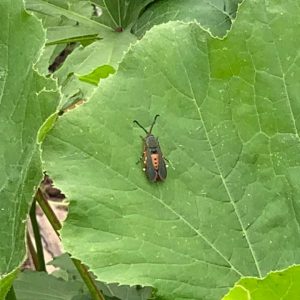
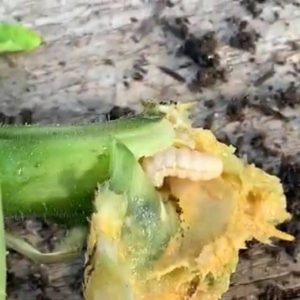
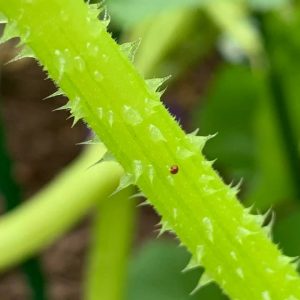
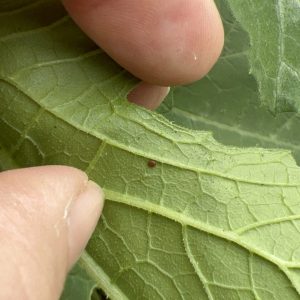
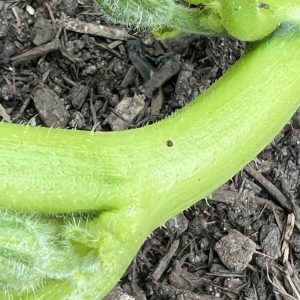
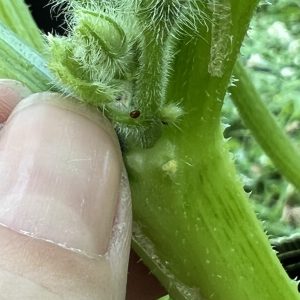
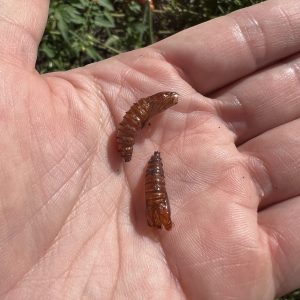
SQUASH VINE BORERS (Melittia cucurbitae)
FOUND ON: Squash
CHARACTERISTICS:
- Adult is a red and black moth that looks like a wasp because it has clear wings
- Larvae is a white grub that burrows into the plant, making them hard to see
- Lays a single brown, round, and slightly flat egg, usually at the base of the plant but can often targets leaves, stems, and blossoms as well
- Pupates underground in a cycle, emerging to leave brown chrysalis shell behind
WHAT THEY DO:
Larvae burrow into the plant’s stem and feed on the insides, often traveling down to the main base of the stem where they cut off pathways to nutrients and water, usually killing the plant.
TREATMENTS / SOLUTIONS:
- Early prevention is best by finding and removing eggs and larvae (packing tape works great to get the eggs)
- Wrap the base of the plant in foil or athletic tape
- Look for areas of the plant that are chewed into, leaving behind “frass” (looks like sawdust)
- Remove leaves near damage and cut into the plant to find the grub
- Bury any exposed stems to try and force new roots so the plant has more support
- Bt organic bacteria-based spray – DIRECT PRODUCT LINK HERE
- SVB sticky traps with pheromones attract the male wasps – DIRECT PRODUCT LINK HERE
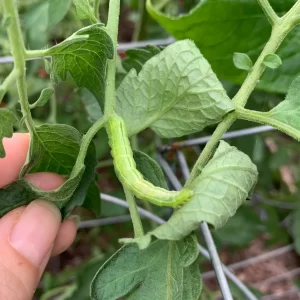
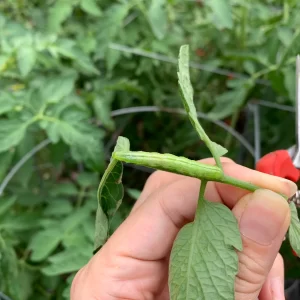
TOMATO LOOPER (Chrysodeixis chalcites)
FOUND ON: Tomatoes and Sweet Peppers
CHARACTERISTICS:
- Small green caterpillar with yellow striping
- Easily recognized because they crawl by arching their backs like an inch worm
WHAT THEY DO:
Foliage feeder
TREATMENTS / SOLUTIONS:
- Spray them off with water as soon as possible.
- Try spraying insecticidal soap or mix a little Dawn dish soap in water.
- Encourage beneficial aphid-eating bugs, like ladybirds, praying mantis, hoverflies, lacewings and their respective larvae, plus predatory wasps. These beneficial insects also dine on nectar from many flowers, so try growing herbs like oregano and dill, and flowers like sweet alyssum, nasturiums, buckwheat, and bachelor buttons.
- Bt organic bacteria-based spray – DIRECT PRODUCT LINK HERE
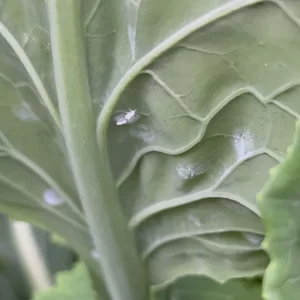

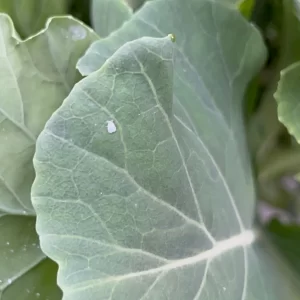
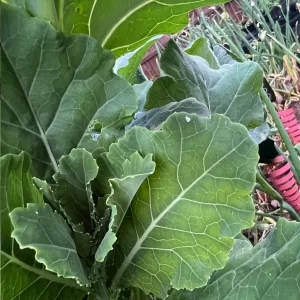
WHITEFLIES (Aleyrodes proletella)
FOUND ON: Tomatoes, peppers, eggplant, cucumbers, but esp the undersides of brassica leaves (cabbage, kale, collards, broccoli, etc).
CHARACTERISTICS:
- Tiny white flying insects that fly up in clouds from the underside of brassica leaves when disturbed.
- Whiteflies resemble small 2 mm moths.
- Whiteflies lay white, cone-shaped eggs in a circular pattern on the underside of leaves.
- Nymphs are tiny, immobile, waxy little lumps with an appearance similar to scale insects.
- They leave white sooty circular areas that look like mold or powdery mildew.
WHAT THEY DO:
Sap suckers – they use their piercing mouthparts to suck the sap out of plants. Larvae feeding on sap secrets “honeydew” which can develop sooty mold or attract ants. They do not normally affect edible parts of the plant and are not super destructive, but annoying when they fly up in your face. The leave white splotches on leaves that are hard to remove.
TREATMENTS / SOLUTIONS:
- Remove infested leaves.
- Spraying insecticidal soap or mix a little Dawn dish soap in water.
- Neem oil
- Ladybugs
- Coat yellow index cards in petroleum jelly, to exploit the insects’ attraction to the color, at plant height.
- Companion cropping: try growing marigolds, basil, chives, nasturtiums, garlic, petunias.
- Reflective mulch deters whiteflies by disorienting them with reflected light.
